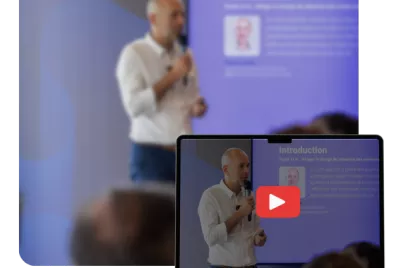
In many data integration projects, technical documentation remains a weak point. It is time-consuming, often incomplete, and rarely up to date. Yet, it is essential for understanding flow logic, ensuring maintenance, and guaranteeing knowledge transfer within teams.
To address this need, we developed GenDoc, an innovative solution that allows you to transform your Talend sources into clear and structured documentation in just a few clicks.
Transform your Talend sources into documentation in one click
The principle is simple: you upload your Talend sources (.item)—whether it is a parent job and the child jobs it calls—and indicate the main job for which the documentation should be generated. In seconds, GenDoc analyzes the structure, dependencies, components, and context variables, and automatically generates complete documentation.
This documentation provides an overview of the flow while detailing essential technical elements. The result is readable, consistent, and easy to integrate into your collaborative tools (such as Confluence or a Git repository).
A multilingual generation for a standardized team documentation
GenDoc is not limited to a single language. You can generate your documentation in French, English, German, or Spanish according to your needs. This feature is particularly useful for international companies or distributed teams, enabling standardized documentation accessible to all stakeholders, regardless of their location or working language.
A demo site to test feasability
The GenDoc site was designed as a demonstration space.
The goal: to allow you to test Talend documentation generation without installation or complex configuration, so you can see the efficiency of our solution for yourself.
⚠️ Note: This site is not intended to process large volumes of files. It is recommended to upload no more than 10 .item files.
The aim is to demonstrate the feasibility of automatic generation and illustrate the potential of the GenDoc engine. For large-scale usage or integration into your CI/CD pipelines, we provide a complete backend API, allowing you to automate calls to the documentation engine.
Next step ? Switch to automation via our backend API
If the results obtained via the demo site convince you, the logical next step is to integrate GenDoc directly into your processes. Our backend API allows you to automate calls to the documentation engine for seamless integration without manual intervention.
You can trigger documentation generation from your existing systems—for example, from your Git repository, CI/CD workflows, or internal scripts. This paves the way for living, dynamic, and always up-to-date documentation, synchronized with the evolution of your Talend sources.
Three concrete use cases to test GenDoc power
1. Nightly documentation (Git integration)
Imagine this: you code all day and push your changes to Git before leaving in the late afternoon. The next morning, when you arrive at the office, your Talend documentation has already been updated overnight.
This is the principle of nightly documentation: every night, GenDoc automatically analyzes the latest Git commits, identifies changes in your Talend jobs, and updates the corresponding documentation without any manual action.
Result :
- Documentation that is always up to date and aligned with the actual code.
- Better visibility for maintenance teams.
- A drastic reduction in time spent documenting.
In short: You code by day, GenDoc documents by night.
2. One-shot documentation
In this use case, GenDoc analyzes all jobs in a Talend project at once to generate complete documentation for an existing project.
This is the ideal soltuion for :
- Taking over a project where documentation is missing or obsolete.
- Conducting a technical audit before a transfer of responsibility.
- Facilitating knowledge transfer between teams.
- Preparing initial documentation prior to production deployment.
In a few minutes, you obtain a clear and actionable deliverable, structured in Markdown format and ready to be published in your internal tools.
3. Compliance with development standards
Beyond documentation generation, GenDoc can also be used to verify the compliance of your developments against your internal standards.
Before each production release, you can define a list of rules or best practices (component naming, context management, use of tMap, etc.). Our backend API analyzes your Talend jobs according to these criteria and returns a compliance rate along with improvement recommendations.
Imagine a clear report before every deployment :
- 92% Global Compliance
- Flagged Jobs: Database connection not closed, component label missing, etc.
- Recommendation: Standardize naming conventions.
A simple and automated way to ensure the quality and maintainability of your Talend developments while respecting your internal standards.
Known limitations and best practices
As with any evolving tool, GenDoc has certain known limitations:
- The demonstration site is not designed for large volumes of files. For industrial use, it is recommended to use the API.
- The job author is not recognized because the .properties files and the .talend-project file are not included in the uploaded sources.
- Documentation generation is currently limited to Markdown format, which is perfectly adapted for collaborative tools such as Confluence or Git.
These limits do not prevent you from obtaining a solid proof of concept and understanding the potential of documentation automation.
Why choose GenDoc ?
- Considerable Time Savings : No more manual writing; documentation is generated automatically from sources.
- Homogeneous Quality : Every job is documented using the same template, guaranteeing clarity and consistency.
- Multilingual : Generate in French, English, German, or Spanish according to your needs.
- Easy Integration :The API allows you to automate the entire process.
- Workflow Adapted : Works equally well for one-off use or continuous automation.
- Quality Control : Verify the compliance of your jobs before every production release.
With GenDoc, Synotis provides a concrete and innovative solution to automate Talend source documentation. This project perfectly illustrates how software intelligence can simplify tedious tasks and add value to developers' work by making their flows more readable, better documented, and therefore more sustainable.
Try the demonstration on GenDoc today and discover how to transform your Talend sources into clear, multilingual, and automatable documentation.
Have a question? Need to scale up? Let's discuss it!


